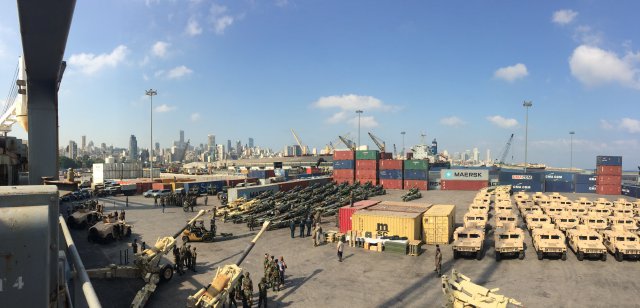How to Improve Return on Investment for Security Assistance
Editor’s Note: Making other countries more effective U.S. security partners is a vital part of counterterrorism, counterinsurgency and U.S. foreign policy in general. Yet it seems to fail often, and support for such aid appears to be declining. Part of the problem may be in how the United States does such assistance. Stephen Tankel of American University and Melissa Dalton of the Center for Strategic and International Studies argue that the United States should reverse its traditional approach.

Published by The Lawfare Institute
in Cooperation With

Editor’s Note: Making other countries more effective U.S. security partners is a vital part of counterterrorism, counterinsurgency and U.S. foreign policy in general. Yet it seems to fail often, and support for such aid appears to be declining. Part of the problem may be in how the United States does such assistance. Stephen Tankel of American University and Melissa Dalton of the Center for Strategic and International Studies argue that the United States should reverse its traditional approach. Instead of punishing partners that don't live up to their end of the bargain, the United States should reward those that do—carrots, in other words, not sticks.
***
Security assistance is an expensive tool of statecraft, even if it is just one component of a total foreign aid allotment that represents only about one percent of the total U.S. budget. In FY 2015, the tab totaled an estimated $16.8 billion. Security assistance includes all grant assistance programs through which the United States provides defense articles, military training, and other defense-related services. The United States uses this assistance not only to build the capacity of allies and partners, but also to try to shape their behavior. Though this latter effort often fails, recipients rarely suffer the consequences.
A rare exception occurred last week. Trump administration sources acknowledged that the United States plans to withhold up to $290 million in aid to Egypt over democracy and human rights concerns. This is likely to prompt renewed debate over whether U.S. security assistance can be leveraged to promote behaviorial change in a recipient country. The decision was particularly surprising because President Trump has exhibited little interest in promoting democracy or human rights concerns. Yet perhaps it should not have been considering that he is skeptical about helping other countries deal with “their problems,” especially given the costs involved. Many Americans appear to share his skepticism.
The critics have a point. The reality is, the U.S. government has few mechanisms to reliably track how its security assistance dollars are performing in terms of return on investment for meeting strategic and policy goals. There have been a number of steps taken in the last three years to start to change that, through executive and legislative branch action. However, even the most ardent supporters of alliances and partnerships must acknowledge that the return on security assistance is often lower than it could be. More than merely wasting taxpayers’ dollars, this damages U.S. credibility and reinforces the belief that maintaining alliances and partnerships is simply not worth the costs involved.
We firmly believe security assistance should remain a critical pillar of U.S. statecraft. We also believe the United States could get a better rate of return on some of these programs by changing the way it conditions assistance. Changing the way the United States conditions assistance could change that for the better. This will not solve the problem of how to optimize our relationships with other countries—there is no silver bullet for that—but it would help the United States get more bang for its buck. This is a sentiment that should appeal to the dealmaker-in-chief.
The Swiss Army Knife of Statecraft
Security assistance objectives can be grouped into two buckets:
The first set of objectives falls under the umbrella of building partner capacity, which has become a catchall for a wide array of programs. This set of objectives includes building the capacity and capabilities of recipients to operate independently against shared threats; buttressing the military strength of friendly countries to positively influence the balance of power and provide deterrence and assurance in a given region; supporting coalition partners that assist the United States in an ongoing conflict; promoting interoperability to enable joint military missions; reducing internal instability and promoting governance and rule of law in countries where threats to the United States could manifest; and professionalizing partner forces.
Wielding influence and securing tactical cooperation is the second. This may translate into trading assistance for access to bases, airspace, or other transit routes. The United States sometimes uses assistance to incentivize short-term tactical cooperation against shared threats. In other cases, assistance is intended to reassure allies and partners of America’s commitment to its security, either in general or against common enemies. Here it is worth noting that plans to slash the State Department’s budget and cut foreign assistance compound concerns about U.S. abandonment and further reduce American influence. Finally, the United States has tried, often without success, to use assistance as a lever to shape a recipient’s behavior either domestically or internationally.
As a result of competing priorities, the United States often chooses not to condition assistance ... or attempts to do so in an ad hoc manner.
Some U.S. objectives overlap with one another. Others conflict. And lest we forget, our partners also get a vote. American objectives for security assistance often do not align with theirs, due in large part to differences in how the United States and a recipient prioritize and perceive threats. The number of different objectives at play complicates efforts to condition assistance; enforcing conditions to achieve one set of objectives could hamper efforts to achieve another set. For example, after the Bahraini government’s security forces launched a major crackdown on protesters during the Arab uprisings, the United States temporarily restricted arms sales to the country. Some members of the Obama administration also argued for placing conditions on security assistance. Others worried that this would undermine Bahrain’s support for U.S. basing and access, which is important for Afghanistan, Iran deterrence, and counterterrorism operations. As a result of competing priorities, the United States often chooses not to condition assistance, as was the case with Bahrain, or attempts to do so in an ad hoc manner. Worst of all, the United States sometimes imposes conditions, but then blinks first and backs down when they are not met.
Playing Chicken with Assistance
Any conversation about conditioning assistance should begin with what fails to work and why. Failed efforts to change a recipient’s behavior by conditioning assistance often share one or more characteristics. First, these efforts are almost always unilateral, meaning the United States imposes conditions without negotiating with the recipient in advance. Conditions are also sometimes retroactive, which is to say they are placed on already existing aid packages, which the recipient may view as an entitlement. This has been the case with Egypt.
Although Congress appropriates and authorizes this assistance every year, the United States has traditionally provided foreign assistance to both Egypt and Israel since the 1979 peace treaty to smooth security cooperation and maintain a balance of power between the two countries. Egypt has received $1.3 billion in military assistance per year since 1987. Following Egypt’s waves of authoritarian crackdowns in 2013, the Obama administration temporarily froze F-16 aircraft deliveries and other equipment to the Egyptian military. It lifted the hold two years later following improved relations with Egypt’s President Abdel Fattah el-Sisi and amid growing concerns about jihadist insurgency there. Some U.S. lawmakers objected to the decision to lift the holds, pointing out that Egypt had failed to follow through on governance reforms. The administration’s decision to lift the holds also may have been an acknowledgement that they were not effectively changing Egyptian government behavior. In parallel, the U.S. administration also began to restructure U.S. assistance for Egypt to focus more on counterterrorism, deemphasizing large conventional arms sales that had historically been a feature of the relationship. Throughout this period, Egypt viewed these restrictions as an affront to its decades-long assistance relationship with the United States. Notably, Egypt and Israel are two of the few countries that would not see its foreign military financing (FMF) shrink in the Trump administration.
The Trump administration has reportedly expressed concerns over Egypt’s implementation of a law restricting the activities of NGOs to development and social work, as a way for the Egyptian government to further constrict popular dissent and civil society. As a result, the U.S. administration is reprogramming $65.7 million in FY 2017 FMF (as well as $30 million in FY 2016 Economic Support Funds) and withholding $195 million in FY 2016 FMF, the latter pending Egyptian improvement on its human rights and democracy record. Egypt’s view that it is entitlted to its annual FMF appropriation, along with the importance of the U.S.-Egyptian security cooperation relationship, will likely obstruct meaningful changes in Egyptian government behavior with respect to democracy and human rights.
[T]here is often an imbalance between what the United States is asking and what it is offering, as well as a misperception of the degree of leverage the United States has to get what it wants.
Second, although the executive branch can place its own internal conditions on releasing assistance, it is Congress that can mandate by law whether or not money is spent. Legislators are often reluctant to tie the hands of the executive branch and so build in waivers on the conditions they devise. This creates situations in which Congress imposes conditions and the administration caves (and waives) when the conditions are not met, usually for overriding U.S. national security imperatives. This cycle of imposing conditions and waiving them has been most evident in the case of Pakistan, where the Obama administration’s worries about jeopardizing access to Afghanistan or losing other limited counterterrorism cooperation overrode congressional attempts to change Pakistan’s behavior in terms of supporting various terrorist groups and correcting the civil-military imbalance in the country. Over time, this pattern eroded the credibility of the conditions. There are fewer examples of Congress imposing conditions that cannot be waived, but here the record is not especially promising either.
Third, there is often an imbalance between what the United States is asking and what it is offering, as well as a misperception of the degree of leverage the United States has to get what it wants. As one of us found in a recent study and the other demonstrates in a forthcoming book, the non-compliance costs for the partner must be higher than the costs of adherence. Conditions are unlikely to work if they are intended to realize changes in behavior that would require a recipient government to alter its vital national interests or elites in that government to cede power. For example, after the Arab uprisings, the Sunni-minority regime in Bahrain dispatched its security forces to crack down on Shia protesters seeking governance reforms. The United States tried to use negative conditionality (placing a hold on assistance) to halt this behavior, but to no avail. When negative conditionality fails, this puts the United States in a precarious position because it must be prepared to stand firm. Yet, if a recipient is providing a good that America is loath to lose—as was the case in Bahrain, Pakistan, and Egypt—this makes it easier for that country to refuse entreaties on other issues and keep assistance flowing. This damages U.S. credibility and encourages countries to extract as much assistance as possible, while doing the minimum in return. It also makes defending the utility of security assistance more difficult.
Implementing Positive Conditionality
Negative conditionality, which is what many people think of when the idea of conditioning assistance comes up, entails threatening to end, suspend, or reduce assistance if conditions are not met. Positive conditionality, which has been used for years in the development world, promises assistance in return for “good behavior” that is defined in advance. Rather than authorizing aid and then withholding it, the United States would identify positive actions that a recipient is considering—or at least open to taking—and then incentivize them. Critically, we argue the process of identifying these actions and benchmarks to measure them should be done in consultation with the recipient. This would help to reduce the potential for mismanaged expectations on either side and get the recipient more invested in the process, signaling that it is a partner and not merely a proxy benefiting from U.S. paternalism. It would also reduce the chances for caving by the United States. Positive conditionality may also be the most optimal route for cases where the United States has little leverage over a recipient, but where the recipient desires further U.S. engagement and investment. We envision at least three different ways to implement this approach.
First, draft a memorandum of understanding with the partner nation that articulates a road map for the relationship. Currently, all grant security assistance to U.S. foreign partners carries conditions to ensure that the partner implements the assistance according to an agreed upon schedule and plan. In reality, this mainly guarantees that the partner can absorb the assistance and that sustainment needs are met. There is no established policy framework for leveraging security assistance to achieve broader foreign policy goals. The type of roadmap we envision would address this deficiency. It would include the shared goals of U.S. assistance, metrics for success, methods of measurement, and the consequences for the partner if these metrics are not met. For example, the United States might tie additional or more sophisticated assistance to benchmarks for reforms. Such a document should be classified or kept in sensitive channels to ensure maximum frankness in crafting the document and to enable deft diplomatic and public messaging on both sides.
Second, tie the ongoing provision of a certain piece of equipment or weapons system to its use for a specific, measurable purpose—such as a shared operational objective like clearing, securing, and transforming terrority from a terrorist organization and transitioning it back to civilian authorities. This would be more expansive than current end-use monitoring, which mainly aims to ensure that arms and equipment are not misused and remain within the security force to which they are assigned. We envision using their provision as a way to incentivize certain actions, for example by providing specific munitions on the condition that the recipient takes certain actions with them that meet U.S. security objectives. A key to this type of conditionality lies in providing specific goods that other countries do not manufacture, thereby enabling the United States to control the flow of these goods based on a partner’s behavior. These goods must also be consumable, unlike a weapons platform that can be reused and which is not easily taken back.
Third, set aside a portion of the total amount authorized for security assistance to the partner for a grant program modeled on those administered by the Millennium Challenge Corporation (MCC). In the MCC process, partner nations identify their priorities (for achieving sustainable economic growth and poverty reduction in the case of MCC money), and work with MCC teams to refine an assistance program. Countries must also meet certain criteria to qualify for MCC funds, the monitoring of which is typically rigorous and transparent. In a security assistance model, partners could be rewarded for achieving strategic and military goals that tie to sustainable governance and stability. Higher order or more difficult goals could be matched with a greater degree or sophistication of security assistance, with partners being able to “graduate” to more competitive grant levels once lower threshold goals are met.
In cases where MOUs are signed, negotiating roadmaps that include longer-term milestones could also ameliorate partner’s anxieties about abandonment. Positive conditionality is unlikely to prompt major changes in a partner’s behavior, but neither is the current approach toward assistance. The approach outlined above could promote tactical shifts in behavior or incremental steps toward reform that might have strategic effects over time. The U.S. security assistance relationship with Lebanon, particularly in the development of the Lebanese Armed Forces (LAF)s’ special operations forces (SOF) to counter Sunni extremist groups in Lebanon since 2007, can provide examples of rewarding performance with increasing capabilities. This assistance helped Lebanese SOF retake control of a refugee camp from Fatah al-Islam, an al-Qaeda associated terrorist group. Today, Lebanese SOF are a critical partner in ensuring the Islamic State and al-Qaeda affiliates do not seep through the Lebanese-Syrian border.
Finally, where capacity building—vice cooperation or reform—is the objective, positive conditionality can ensure that the partner is investing its own funds to support or sustain the capacity being built. Investing early—i.e., before a crisis—provides additional space to take a firmer line with partner forces. This is not always possible. Where it is, the United States should seize these opportunities.






